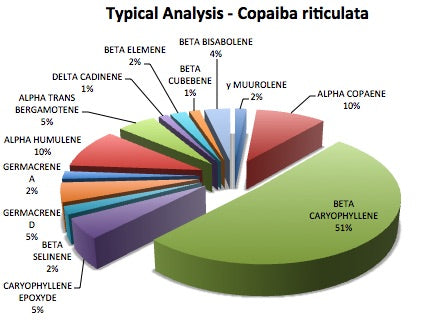
Discover Copaiba (Copaifera riticulata)
Share
Copaiba (Copaifera riticulata) is a sap-like substance (oleoresin) collected from the trunk of trees that belong to the Copaifera species

The Copaifera genus comes from Leguminosae family. There are several species of Copaifera; Absolute Aromas chooses Copaifera reticulata, the oil is derived from steam distillation of the gum/resin of a tree that is native to the Brazilian Amazon. Only recently it has gained popularity in Aromatherapy, however, the resin has been used in folklore medicine since the 16th century for its medicinal properties.
Aromatically, Copaifera riticulata essential oil has a deep, rich, grounding earthy aroma. The resin/oil acts as a fixative base note in natural perfuming.

This deep full bodied resin/oil is rich in sesquiterpenes mostly beta-caryophyllene, a precious constituent in the Aromatherapy repertoire, contributing to its anti-inflammatory, analgesic properties and also helps relieves anxiety and depression.
Recently it has been demonstrated that beta-Caryophyllene interacts with the endocannabinoid system; acting as a natural agonist of the endogenous Cannabinoid receptor 2 (CB2). (CB2 receptors are known to be expressed in immune cells and facilitate anti-inflammatory effects.)
Contraindications: Non-toxic and non-irritant when used below 2% dilutions. Do not use during pregnancy or breastfeeding. Keep away from children. Do not used on cracked injured skin.
In typical aromatherapy applications, it can be used at a 1-2% dilution (6-12 drops in 30 MLS of base oil, cream or Aloe gels. The essential oil can be used in pain relieving formulas and also to help prevent infection throughout the winter months. Use 6-8 drops of the essential oil in a nasal inhaler to calm and soothe and balance the emotions.
Formulation Corner
Muscular Aches & Body Oil
- 50 mL of Almond
- 6 drops of Copaifera riticulata
- 10 drops of Lavender High Altitude
- Blend in a beaker, pour into a 50mL amber bottle. Apply oil after shower or bathing.
Pain Relief Gel
- 40 mL of Aloe Vera Gel
- 20 drops of St.Johns Wort
- 5 drops of Spike Lavender
- 3 drops of Copaifera riticulata
- 3 drops of Black Spruce
Add aloe gel into a 50 glass jar. Blend essential oils into the St. Johns wort, mix into the aloe gel and topically on joints.
Winter Musk Perfume
- 3 drops of Copifera riticulata
- 3 Drops of Black Spruce
- 2 Drops of Benzion
- 1 Drop of Galbanum
- 6 Drops of Rose Absolute
- 10 drops of Lime Distilled
- 50 MLS of Jojoba
References
1. Gertsch J, Leonti M, Raduner S, Racz I, Chen J, Xie X et al. Beta-caryophyllene is a dietary cannabinoid. Proceedings of the National Academy of Sciences. 2008;105(26):9099-9104.
2. Ghelardini C, Galeotti N, Di Cesare Mannelli L, Mazzanti G, Bartolini A. Local anaesthetic activity of β-caryophyllene. Il Farmaco. 2001;56(5-7):387-389.
3. Bahi A, Al Mansouri S, Al Memari E, Al Ameri M, Nurulain S, Ojha S. β-Caryophyllene, a CB2 receptor agonist produces multiple behavioral changes relevant to anxiety and depression in mice. Physiology & Behavior. 2014;135:119-124.
4. Almeida M, Darin J, Hernandes L, Ramos M, Antunes L, Freitas O. Genotoxicity assessment of Copaiba oil and its fractions in Swiss mice. Genetics and Molecular Biology. 2012;35(3):664-672.
5. Tisserand R, Young R, Williamson E. Essential oil safety. Edinburgh [etc.]: Churchill Livingstone/Elsevier; 2014.
6. Photography; Creative Commons and Istock








